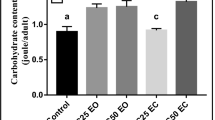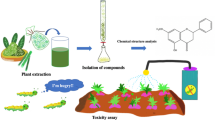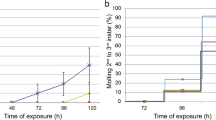Abstract
This present study aims to evaluate the insecticidal activity of a bioactive molecule, menthol, against a pest species, Rhyzopertha dominica (F. 1792) (Coleoptera: Bostrichidae). Effects were examined on mortality, enzymes of intermediary metabolism (ALP, GOT and GPT), nutritional reserves, digestive enzymes, and oxidative stress biomarker. Toxicological tests revealed the insecticide activity of this treatment with a dose–response relationship. In addition, ingestion (LC50 at 24 h: 0.69 µl/ml) is the most effective mode of application compared to fumigation (LC50 at 24 h: 302 µl/L air). The obtained results revealed an increase in the percent repellency as a function of concentrations. Moreover, the biochemical study shows that the treatment decreases the protein content and the energy reserves. In addition, it disrupts the activity of enzymes of intermediary metabolism (ALP, GOT and GPT) in R. dominica adult. Finally, menthol also disrupts the digestive enzymes activity in treated adults compared to controls. Indeed, the treatment reduces the specific activity of α-amylase, protease, chitinase, and lipase.



Similar content being viewed by others
References
Abbott WB (1925) A method for computing the effectiveness of an insecticide. J Econ Entomol 18:265–267
Abdelgaleil S, Mohamed M, Badawy M, El-arami S (2009) Fumigant and contact toxicities of monoterpenes to Sitophilus oryzae (L.) and Tribolium castaneum (Herbst) and their inhibitory effects on acetylcholinesterase activity. J Chem Ecol 35:518–525. https://doi.org/10.1007/s10886-009-9635-3
Abdel-Latif AM, Moajel NH (2004) Some biochemical effects of natural mint oil on some species of stored grain pests. Mansoura J Agr Sci 9(9).
Abed-Vieillard D, Cortot J, Everaerts C, Ferveur JF (2014) Choice alters Drosophila oviposition site preference on menthol. Biol Open 3:22–28
Abo El Makarem HE, El Kholy S, Abdel-Latif AI, Seif A (2015a) Physiological and biochemical effects of some essential oils on the granary weevil, Sitophilus granarius (L) (Coleoptera: Curculionidae). Egypt Soc Exp Biol 11(2):117–123
Aggarwal KK, Tripathi AK, Ahmad A, Prajapati V, Verma N, Kumar S (2001) Toxicity of l-menthol and its derivatives against four storage insects. Int J Trop Insect Sci 21:229–235
Arrese EL, Soulages JL (2010) Insect fat body: Energy, metabolism, and regulation. Ann Rev Entomol 55:207–225
Arshad M, Hasan SN, Kham MF, Akhtar K, Khan FX (1999) Comparative toxicological studies of RBa (neem extract) and (permethrin + bioallethrin) against Sitophilus oryzae with reference to their effects on oxygen consumption and GOT, GPT activity. Turk J Zool 22:307–310
Beenakers AM, Van der Horst DJ, Van Marrewijk WJ (1985) Insect lipids and lipoproteins, and their role in physiological processes. Prog Lipid Res 24(1):19–67
Bernfeld P (1955) Amylases, alpha and beta. Methods Enzymol I:149–158
Bradford MM (1976) A rapid and sensitive method for the quantitation of microgram quantities of protein utilizing the principle of protein-dye binding. Analyt Bio Chem 72(1–2):248–254
Chapman RF, Stephen J, Simpson A, Douglas E (2013) The insects structure and function. Press, Cambridge, Cambridge Uni
Duchateau G, Florkin M (1959) Sur la tréhalosémie des insectes et sa signification. Arch Inter Physiol Bioch 67(2):306–314
Dutra K, Wanderley-Teixeira V, Guedes C, Cruz G, Navarro D, Monteiro A, Agra A, Neto CL, Teixeira A (2020) Toxicity of essential oils of leaves of plants from the genus Piper with influence on the nutritional parameters of Spodoptera frugiperda Smith (Lepidoptera: Noctuidae). J Essent Oil Bear Plants 23:213–229. https://doi.org/10.1080/0972060X.2020.1756423
Ebadollahi A (2013) Essential oils isolated from Myrtaceae family as natural insecticides. Ann Res Rev Biol 148–175.
El-Saadony MT, Saad AM, Elakkad HA, El-Tahan AM, Alshahrani OA, Alshilawi MS, El-Sayed H, Amin SA, Ahmed AI (2022) Flavoring and extending the shelf life of cucumber juice with aroma compounds-rich herbal extracts at 4 °C through controlling chemical and microbial fluctuations. Saudi J Biol Sci 29:346–354
Enan EE (2005) Molecular and pharmacological analysis of an octopamine receptor from American cockroach and fruit fly in response to plant essential oils. Arch Insect Biochem Physiol 59:161–171. https://doi.org/10.1002/arch.20076
Erler F (2005) Fumigant activity of six monoterpenoids from aromatic plants in Turkey against the two stored-product pests confused flour beetle, Tribolium confusum, and Mediterranean flour moth. Ephestia Kuehniella J Plant Dis Prot 112(6):602–611
Garcia-Carreno FL, Haard NF (1993) Characterization of protease classes in langostilla (Pleuroncodes planipes) and crayfish (Pacifastacus astacus) extracts. J Food Biochem 17(2):97–113
Gatehouse JA, Gatehouse AMR (1999) Genetic engineering of plants for insect resistance. In: Rechcigl JE, Rechcigl NA (eds) Biological and biotechnological control of insect pests. CRC Press, Boca Raton, FL, pp 211–241
Goharrostami M, Sendi JJ, Hosseini R, Mahmoodi NA (2022) Chemical composition, toxicity and physiological effects of thyme oil and its two components on mulberry pyralid moth. Res Square. https://doi.org/10.21203/rs.3.rs-1613448/v1.
Goldsworthy GJ, Mordue W, Guthkelch J (1972) Studies on insect adipokinetic hormones. Gen Comp Endocrinol 18(3):545–551
Gong X, Ren Y (2020) Larvicidal and ovicidal activity of Carvacrol, p-cymene, and γ-terpinene from Origanum vulgare essential oil against the cotton bollworm, Helicoverpa armigera (Hübner). Environ Sci Pollut Res 27:18708–18716. https://doi.org/10.1007/s11356-020-08391-2
Guettal S, Tine S, Tine-Djebbar F, Soltani N (2020) Effect of Citrus limonum essential oil against granary weevil, Sitophilus granarius and its chemical composition, biological activities and energy reserves. Inter J Trop Insect Sci 41:1531–1541
Guettal S, Tine S, Kaouther H, Tine-Djebbar F, Soltani N (2021a) Combined effects of Azadirachtin and Citrus limonum essential oil against Sitophilus granarius: Toxicity and biological activities. Pest Res J 33(1):78–86
Guettal S, Tine S, Tine-Djebbar F, Soltani N (2021b) Repellency and toxicity of azadirachtin against granary weevil Sitophilus granarius L. (Coleoptera: Curculionidae). https://hal.archives-ouvertes.fr/hal-03169471.
Hakkak R, Gauss C, Bell A, Korourian S (2018) Short-term soy protein isolate feeding prevents liver teatosis and reduces serum alt and ast levels in obese female zucker rats. Biomed 6:55–66
Hasheminia SM, Sendi JJ, Jahromi KT, Moharramipour S (2011) The effects of Artemisia annua L and Achillea millefolium L crude leaf extracts on the toxicity, development, feeding efficiency and chemical activities of small cabbage Pieris rapae L. (Lepidoptera: Pieridae). Pest Biochem Physiol 99(3):244–249
Hassan HA (2002) Biological and biochemical studies on the effects of some botanical extracts on cotton leaf worm Spodoptera littoralis (Boisd.) (Lepidoptera: Noctuidae). Dissertation, University of Ain Shams.
Himmel NJ, Letcher JM, Sakurai A, Gray TR, Benson MN, Cox DN (2019) Drosophila menthol sensitivity and the Precambrian origins of transient receptor potential-dependent chemosensation. Phil Trans r Soc B 374:20190369. https://doi.org/10.1098/rstb.2019.0369
Khater KS, El-Shafiey SN (2015) Insecticidal effect of essential oils from two aromatic plants against Tribolium castaneum (Herbst) (Coleoptera: Tenebrionidae). Egypt J Biol Pest Control 25:129–134
Khosravi R, Sendi JJ (2013) Effect of neem pesticide (Achook) on midgut enzymatic activities and selected biochemical compounds in the hemolymph of lesser mulberry pyralid, Glyphodes pyloalis Walker (Lepidoptera: Pyralidae). J Plant Prot Res 53(3).
Kiran S, Prakash B (2015) Assessment of toxicity, antifeedant activity, and biochemical responses in stored-grain insects exposed to lethal and sublethal doses of Gaultheria procumbens L. essential oil. J Agric Food Chem 48:10518–10524
Kissoum N, Bensafi-Gheraibia H, Hamida ZC, Soltani N (2020) Evaluation of the pesticide Oberon on a model organism Drosophila melanogaster via topical toxicity test on biochemical and reproductive parameters. Comp Biochem Physiol, Part C 228:108666. https://doi.org/10.1016/j.cbpc.2019.108666
Klowden MJ (2007) Physiological systems in insects. Amsterdam. Elsevier, 688 p. Academic Press.
Lemaitre B, Miguel-Aliaga I (2013) The digestive tract of Drosophila melanogaster. Annu Rev Genet 47:377–404
Lohar MK, Wright DJ (1993) Changes in the lipid content in haemolymph, fat body and oocytes of malathion treated Tenebrio molitor L. Adult Females Pak J Zool 25:57–57
Mann R, Kaufman P (2012) Natural product pesticides: their development, delivery and use against insect vectors. Mini-Rev Org Chem 9(2):185–202
Mardani-Talaee M, Rahimi V, Zibaee A (2014) Effects of host plants on digestive enzymatic activities and some components involved in intermediary metabolism of Chrysodeixis chalcites (Lepidoptera: Noctuidae). J Entomol Acarol Res 46:3224
Mc Donald LL, Guy RH, Speirs RD (1970) Preliminary evaluation of new candidate materials as toxicants, repellents, and attractants against stored-product insects. Washignton D.C, Agricultural Research Service.
Mishra M, Sharma A, Dagar VS, Kumar S (2020) Effects of β-sitosterol on growth, development and midgut enzymes of Helicoverpa armigera Hubner. Arch Biol Sci 72:271–278. https://doi.org/10.2298/ABS200308021M
Mojarab-Mahboubkar M, Sendi JJ, Aliakbar A (2015) Effect of Artemisia annua L essential oil on toxicity, enzyme activities, and energy reserves of cotton bollworm Helicoverpa armigera (Hübner) (Lepidoptera: Noctuidae). J Plant Prot Res 55(4):371–377
Nath BS (2000) Changes in carbohydrate metabolism in hemolymph and fat body of the silkworm, Bombyx mori L., exposed to organophosphorus insecticides. Pest Biochem Physiol 68(3):127–137
Nath BS, Suresh A, Varma BM, Kumar RS (1997) Changes in protein metabolism in hemolymph and fat body of the silkworm, Bombyx mori (Lepidoptera: Bombycidae) in response to organophosphorus insecticides toxicity. Ecotox Envir Saf 36(2):169–173
Nation JL (2008) Insect physiology and biochemistry, 2nd edn. CRC Press, UK, London
Nation JL (2016) Insect physiology and biochemistry. CRC Press, London
Oftadeh M, Jalali-Sendi J, Ebadollahib A (2020) Toxicity and deleterious effects of Artemisia annua essential oil extracts on mulberry pyralid (Glyphodes pyloalis). Pestic Biochem Physiol 170:104702. https://doi.org/10.1016/j.pestbp.2020.104702
Paranagama PA, Kodikara KABCH, Nishantha HMI, Mubarak AM (2001) Effect of azadirachtin on growth and the activity of the midgut enzymes of cockroach Periplaneta americana. J Nat Sci Found Sri Lanka 29(1–2).
Pascual-Ruiz S, Carrillo L, Alvarez-Alfageme F, Ruiz M, Castanera P, Ortego F (2009) The effects of different preyregimes on the proteolytic digestion of nymphs of the spined soldier bug, Podisus maculiventris (Hemiptera: Pentatomidae). Bull Entomol Res 99(5):487–491
Pradel SF, Albert MS (2021) Evaluation of the in vivo energy potency of ethanolic extracts and combinations of extracts from the leaves of Gnetum africanum Welv. and Gnetum buchholzianum Engl. (Gnetaceae): two plants with hepatic potential and antioxidant protection. Sci, Technol Dev 23:14–18 ((in Frensh with English abstract))
Rajkumar V, Gunasekaran C, Christy IK, Dharmaraj J, Chinnaraj P, Paul CA (2019) Toxicity, antifeedant and biochemical efficacy of Mentha piperita L. essential oil and their major constituents against stored grain pest. Pestic Biochem Physiol 156:138–144
Ramzi S, Sahragard A, Zibaee A (2014) Effects of Citrullus colocynthis agglutinin on intermediary metabolism of Ectomyelois ceratoniae Zeller (Lepidoptera: Pyralidae). J Asia Pacific Entomol 17:273–279
Ribeiro PF, Johnson BK, Crow ML, Arsoy A, Liu Y (2001) Energy storage systems for advanced power applications. Proc IEEE 89(12):1744–1756
Sak O, Uçkan F, Ergin E (2006) Effects of cypermethrin on total body weight, glycogen, protein, and lipid contents of Pimpla turionellae (L.) (Hymenoptera: Ichneumonidae). Belg J Zool 136(1):53–58
Samarasekera R, Weerasinghe IS, Hemalal KDP (2008) Insecticidal activity of menthol derivatives against mosquitoes. Pest Manag Sci 4:290–295
Sancho E, Ferrando MD, Fernandez C, Andreu E (1998) Liver energy metabolism of Anguilla anguilla after exposure to fenitrothion. Ecotox Envir Saf 41(2):168–175
Sayada N, Tine S, Soltani N (2021a) Evaluation of a botanical insecticide, lavender (Lavandula angustifolia (M.)) essential oil as toxicant, repellent and antifeedant against lesser grain borer (Rhyzopertha dominica (F.)). Appl Ecol Envir Res 20(2):1301–1324
Sayada N, Tine S, Soltani N (2021b) Toxicity and physiological effects of essential oil from Lavandula angustifolia (M.) against Rhyzopertha dominica (F.) (Coleoptera: Bostrichidae) adults. J Entomol Res 45(suppl):929–936
Selin-Rani S, Senthil-Nathan S, Revathi K, Chandrasekaran R, Thanigaivel A, Vasantha-Srinivasan P, Ponsankar A, Edwin ES, Pradeepa V (2016) Toxicity of Alangium salvifolium wang chemical constituents against the tobacco cutworm Spodoptera litura Fab. Pest Biochem Physiol 126:92–101
Senthil-Nathan S (2013) Physiological and biochemical effect of neem and other Meliaceae plants secondary metabolites against Lepidopteran insects. Front Physiol 4:359
Senthil-Nathan SS, Kalaivani K, Murugan K, Chung PG (2005) The toxicity and physiological effect of neem limonoids on Cnaphalocrocis medinalis (Guenée) the rice leaf folder. Pest Biochem Physiol 81(2):113–122
Senthil-Nathan S, Chunga PG, Muruganb K (2006) Combined effect of biopesticides on the digestive enzymatic profiles of Cnaphalocrocis medinalis (Guenee) (the rice leaf folder) (Insecta: Lepidoptera: Pyralidae). Ecotox Envir Saf 64:382–389
Shahriari M, Sahebzadeh N, Zibaee A (2017) Effect of Teucrium polium (Lamiaceae) essential oil on digestive enzyme activities and energy reserves of Ephestia kuehniella (Lepidoptera: Pyralidae). Invert Surv J 14:182–189
Shahriari M, Sahebzadeh N, Zibaee A (2019) Effects of Teucrium polium L. (Lamiaceae) essential oil and α-pinene on the detoxifying and intermediary engaged enzymes of Ephestia kuehniella Zeller, 1879 (Lep.: Pyralidae). Acta Agric Slov 113(2):251–261
Shekari M, Jalali Sendi J, Etebari K, Zibaee A (2008) Shadparvar A (2008) Effects of Artemisia annua L. (Asteracea) on nutritional physiology and enzyme activities of elm leaf beetle, Xanthogaleruca luteola Mull (Coleoptera: Chrysomellidae). Pest Bioch Physiol 91:66–74
Shibko S, Koivistoinen P, Tratnyek CA, Newhall AR, Friedman L (1966) A method for sequential quantitative separation and determination of protein, RNA, DNA, Lipid, and glycogen from a single rat liver homogenate or from a subcellular fraction. Analyt Biochem 19:514–528
Shimomura K, Oikawa H, Hasobe M, Suzuki N, Yajima S, Tomizawa M (2020) Contact repellency by L-menthol is mediated by TRPM channels in the red flour beetle Tribolium castaneum. Pest Manag Sci. https://doi.org/10.1002/ps.616010.1002/ps.6160
Steele JE (1981) The role of carbohydrate metabolism in physiological function. Energ Metab Insects 101- 133.
Steele JE (1985) Hormonal modulation of carbohydrate and lipid metabolism in fat body. Insect Biol future, Academic Press 253–271.
Sugeçti S, Büyükgüzel K (2018) Effects of oxfendazole on metabolic enzymes in hemolymph of Galleria mellonella L. (Lepidoptera: Pyralidae) larvae reared on artificial diet. Karaelmas Sci Engin J 8(2).
Tabassum R, Jahan M, Naqvi SNH (1994) Determination of toxicity of Sisthion and RB–a formulation (neem extract) against Tribolium castaneum (Herbst) adults and their effect on transaminases. Neem Newslett (india) 11(1):7–9
Talukder FA, Howse PE (1994) Repellent, toxic and food protectant effects of pithraj, Aphanamixis polystachya (Meliaceae) against the pulse beetle, Callosobruchus chinensis, in storage. J Chem Ecol 20:899–908
Tine S, Halaimia A, Chechoui J, Tine-Djebbar F (2017) Fumigant toxicity and repellent effect of azadirachtin against the lesser grain beetle, Rhyzopertha dominica (F.) (Col.: Bostrichidae). In: Recent advances in environmental science from the Euro-Mediterranean and surrounding regions, A Kallel, M Ksibi, H Ben Dhia and N. Khelifi (Eds), Springer, Cham, pp 399–401.
Tine S, Brahmi A, Yousfi R (2021a) Lutte contre les ravageurs des stocks. Noor Publishing. ISBN: 978-620-3-85842-6.
Tine S, Soltani M, Abess N (2021b) Utilisation des huiles essentielles dans la lutte contre les insectes des denrées stockées. Editions Universitaires Européennes. ISBN: 978-620-3-42165-1.
Tong F, Coats J (2012) Quantitative structure-activity relationships of monoterpenoid binding activities to the housefly GABA receptor. Pest Manag Sci 68(8):1122–1129
Tripathi AK, Prajapati V, Agvawal KK, Khanuja SPS, Kumar S (2001) Repellency and toxicity of oil from Artemisia annua to ceratin stored product beetles. J Econ Entomol 93:43–47
Tsujita T, Ninomiya H, Okuda H (1989) p-nitrophenyl butyrate hydrolyzing activity of hormone-sensitive lipase from bovine adipose tissue. J Lipid Res 30(7):997–620
Venkatesan T, Jalali SK, Ramya SL, Prathibha M (2016) Insecticide resistance and its management in mealybugs. In: Mani M, Shivaraju C (eds) Mealybugs and their management in agricultural and horticultural crops. Springer, India, pp 223–229
Vijayaraghavan C, Sivakumar C, Kavitha Z, Sivasubramanian P (2010) Effect of plant extracts on biochemical components of cabbage leaf webber, Crocidolomia binotalis Zeller. J Biopest 3(1):275–277
Yazdani E, Sendi JJ, Aliakbar A, Senthil-Nathan S (2013) Effect of Lavandula angustifolia essential oil against lesser mulberry pyralid Glyphodes pyloalis Walker (Lep: Pyralidae) and identification of its major derivatives. Pest Biochem Physiol 107(2):250–257
Zibaee A, Bandani AR (2010) Effects of Artemisia annua L. (Asteracea) on the digestive enzymatic profiles and the cellular immune reactions of the Sunnpest, Eurygaster integriceps (Heteroptera: Scutellaridae), against Beauveria bassiana. Bull Entomol Res 100(2):185–196
Zibaee A, Bandani AR, Ramzi S (2008) Lipase and invertase activities in midgut and salivary glands of Chilo suppressalis (Walker) (Lepidoptera, Pyralidae), rice striped stem borer. Invert Surv J 5(2):180–189
Zibaee A, Bandani AR, Talaei-Hassanlouei R, Malagoli D (2011) Cellular immune reactions of the sunn pest, Eurygaster integriceps, to the entomopathogenic fungus, Beauveria bassiana and its secondary metabolites. J Insect Sci 11(1):1–16
Funding
No funding was obtained for this study.
Author information
Authors and Affiliations
Contributions
TAO and TM involved in data curation, writing, methodology, investigation, formal analysis. F.T.-D., S.T., and N.S. took part in methodology, investigation, writing—review & editing, conceptualization.
Corresponding author
Ethics declarations
Conflict of interest
The authors have no conflicts of interest to declare.
Additional information
Publisher's Note
Springer Nature remains neutral with regard to jurisdictional claims in published maps and institutional affiliations.
Rights and permissions
Springer Nature or its licensor (e.g. a society or other partner) holds exclusive rights to this article under a publishing agreement with the author(s) or other rightsholder(s); author self-archiving of the accepted manuscript version of this article is solely governed by the terms of such publishing agreement and applicable law.
About this article
Cite this article
Tine-Djebbar, F., Trad, M., Tine, A.O. et al. Effects of menthol on nutritional physiology and enzyme activities of the lesser grain borer, Rhyzopertha dominica (F. 1792) (Coleoptera: Bostrichidae). J Plant Dis Prot 130, 509–518 (2023). https://doi.org/10.1007/s41348-023-00727-7
Received:
Accepted:
Published:
Issue Date:
DOI: https://doi.org/10.1007/s41348-023-00727-7




